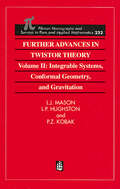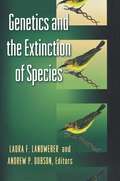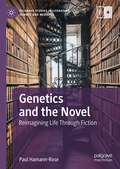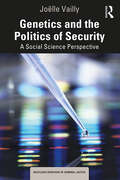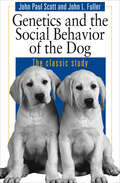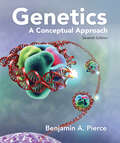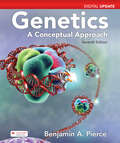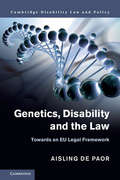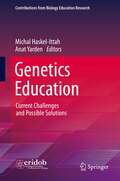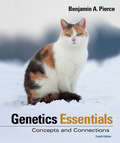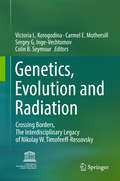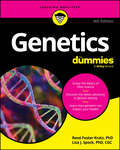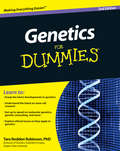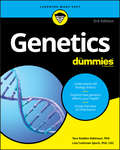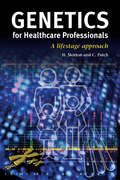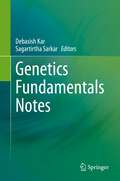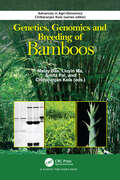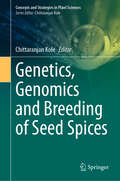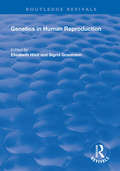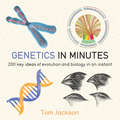- Table View
- List View
Genetics and Randomness
by Anatoly RuvinskyAnalyzes Randomness in Major Genetic Processes and EventsNo matter how far science advances, the proportion of what is knowable to what is random will remain unchanged, and attempts to ignore this critical threshold are futile at best. With the revolutionary explosion in genetic information discovery, it is crucially important to recognize the unde
Genetics and the Extinction of Species: DNA and the Conservation of Biodiversity
by Laura F. Landweber & Andrew P. DobsonDarwin's Origin of Species and Dobzhansky's Genetics and the Origin of Species have been the cornerstones of modern evolutionary and population genetic theory for the past hundred years, but in the twenty-first century, biologists will face graver problems of extinction. In this collection, a team of leading biologists demonstrates why the burgeoning field of conservation biology must continue to rely on the insights of population genetics if we are to preserve the diversity of living species. Technological and theoretical developments throughout the 1990s have allowed for important new insights into how populations have evolved in response to past selection pressures, while providing a broad new understanding of the genetic structure of natural populations. The authors explore these advances and argue for the applicability of new genetic methods in conservation biology. The volume covers such topics as the reasons for extinctions, the best ways to measure biodiversity, and the benefits and drawbacks of policies like captive breeding. Genetics and the Extinction of Species is a rich source of information for biologists and policymakers who want to learn more about the host of tools, theories, and approaches available for conserving biodiversity. In addition to the editors, the contributors to the volume are William Amos, Rebecca Cann, Kathryn Rodriguez-Clark, Leslie Douglas, Leonard Freed, Paul Harvey, Kent Holsinger, Russell Lande, and Helen Steers.
Genetics and the Manipulation of Life
by Craig HoldregeCovers all areas of genetics in simple terms. There are detailed descriptions of the figures contained in the book. Contains glossary and index.
Genetics and the Novel: Reimagining Life Through Fiction (Palgrave Studies in Literature, Science and Medicine)
by Paul Hamann-RoseGenetics and the Novel: Reimagining Life Through Fiction argues that literary fiction has reimagined life in the age of genetics. The new genetic paradigm has proposed to rewrite core assumptions about such fundamental aspects of life as the nature of kinship and biological connection, human-environmental relations, or the link between biology and art. Investigating major texts of genetic fiction by A. S. Byatt, Ian McEwan, Simon Mawer and Margaret Atwood, this monograph offers the first systematic study of how these assumptions about life itself have been renegotiated through the contemporary novel’s engagement with genetic science. This book identifies a significant new phase in the novel’s aesthetic exploration of life and demonstrates that the novel emerges as the cultural form uniquely positioned to engage both the imaginative and concrete challenges raised by genetic science for the lifeworlds of the new millennium.
Genetics and the Politics of Security: A Social Science Perspective (Routledge Frontiers of Criminal Justice)
by Joëlle VaillyPresenting a social science perspective on the contemporary gaze on the body of the suspect, this book considers how definitions of criminality, offenses, individual rights, and the concepts of identity and difference have been altered by changes in the biological status of the human.Spurred by rapid developments in genetics and information technology, a number of countries, including France, the United States, the United Kingdom, China, and the Netherlands, have considerably expanded their genetic databases used by the police and the criminal justice system. Whilst this makes it possible to compare DNA left at the scene of a crime with that of an individual known to the police, helping to identify individuals for the purposes of court proceedings, these innovations also raise a number of important questions, such as how the relationship between respect for the rights of individuals and the security of populations is discussed, as well as for how long this data should be retained. Genetic analysis also raises concerns related to phenotyping and “biogeographical origin” that could lead to the stigmatization of targeted groups.Offering a comprehensively argued view on how DNA acts not only as a tracker of suspicion but also as a marker of contemporary social developments, Genetics and the Politics of Security will appeal to students and scholars, judiciary personnel, lawyers, police officers, and people with an interest in criminology and the use of genetics in the criminal justice process.
Genetics and the Social Behavior of the Dog
by John Paul Scott John L. FullerThe classic study of canine behavior: &“A major authoritative work…Immensely rewarding reading for anyone concerned with dog-breeding.&”—Times Literary Supplement Based on twenty years of research at the Jackson Laboratory, this is the single most important and comprehensive reference work on the behavior of dogs ever compiled, written by geneticist and comparative psychologist John Paul Scott, known for his research into social behavior and aggression. &“One of the most important texts on canine behavior published to date. Anyone interested in breeding, training, or canine behavior must own this book.&”—Wayne Hunthausen, D.V.M., Director of Animal Behavior Consultations &“This pioneering research on dog behavioral genetics is a timeless classic for all serious students of ethology and canine behavior.&”—Dr. Michael Fox, Senior Advisor to the President, The Humane Society of the United States &“Comprehensive…[a] seminal work.&”—Mark Derr, The Atlantic Monthly &“Essential reading for anyone involved in the breeding of dogs. No breeder can afford to ignore the principles of proper socialization first discovered and articulated in this landmark study.&”—The Monks of New Skete, authors of How to Be Your Dog's Best Friend and the video series Raising Your Dog with the Monks of New Skete
Genetics: Bullet Guides Everything You Need to Get Started
by James NapierOpen this book and you will Learn how genes work Look at the latest technologies Tackle controversial issues Understand who you are
Genetics: A Conceptual Approach
by Benjamin A. PierceWith Genetics: A Conceptual Approach, Ben Pierce brings a master teacher’s experiences to the introductory genetics textbook, clarifying this complex subject by focusing on the big picture of genetics concepts and how those concepts connect to one another. The new 7th edition continues this mission by expanding upon the powerful pedagogy and tools that have made this title so successful. New question types, more learning guidelines for students, and an updated art program round out a powerful text, and improvements to the online resources in SaplingPlus give students the conceptual and problem solving understanding they need for success.
Genetics: Concepts And Connections
by Benjamin A. PierceGenetics: A Conceptual Approach 7e Digital Update serves as your trusty steward into the complex world of genetics.
Genetics, Disability and the Law: Towards an EU Legal Framework (Cambridge Disability Law and Policy Series)
by Aisling De PaorWhile advances in science and technology bring many advantages, we must not ignore the harm that they can cause. Rapid changes in genetic testing are a prime example, and indicators can now help to detect, address and treat diseases. However, in this new study, Aisling de Paor examines how genetic testing is also being used for non-medical reasons, for example for work opportunities and insurance coverage. Genetics, Disability and the Law is the first book of its kind to substantively consider an EU-level response to the use of genetic information. de Paor discusses how to help genetic and scientific research to evolve and grow, how to enhance public confidence in research, and how to control it so that it recognises our values and fundamental human rights. An understudied but vitally important topic, de Paor's work provides a valuable and timely contribution to the field of disability rights. Presents a practical consideration of an EU-level legislative response to controlling the use and misuse of genetic information, appealing to those involved in the regulation of this field Takes a human rights and disability approach to considering the regulation of genetic information, which will interest scholars and policymakers from a variety of disciplines, in particular because it considers the intersection of disability and genetics Considers normative and non-normative attitudes to the regulation of genetic information, giving readers a new and varied insight
Genetics Education: Current Challenges and Possible Solutions (Contributions from Biology Education Research)
by Anat Yarden Michal Haskel-IttahThis edited volume presents the current state of the art of genetics education and the challenges it holds for teaching as well as for learning. It addresses topics such as how genetics should be taught in order to provide students with a wide and connected view of the field. It gives in-depth aspects that should be considered for teaching genetics and the effect on the student’s understanding. This book provides novel ideas for biology teachers, curriculum developers and researchers on how to confront the presented challenges in a way that may enable them to advance genetics education in the 21st century. It reviews the complexity of teaching and learning genetics, largely overlooked by biology textbooks and classroom instruction. It composes a crucial component of scientific literacy.
Genetics Essentials: Concepts And Connections
by Benjamin A. PierceDerived from his popular and acclaimed Genetics: A Conceptual Approach, Ben Pierce’s streamlined text covers basic transmission, molecular, and population genetics in just 18 chapters, helping students uncover major concepts of genetics and make connections among those concepts as a way of gaining a richer understanding of the essentials of genetics. <p> With the new edition, Ben Pierce again focuses on the most pervasive problems for students taking genetics—understanding how genetics concepts connect to each other and developing solid problem solving skills. There is updated coverage of important research developments in genetics (CRISPR) and a new Active Learning feature, Think, Pair, Share. And with this edition, Genetics Essentials is available as a fully integrated text/media resource with SaplingPlus, an online solution that combines an e-book of the text, Pierce’s powerful multimedia resources, and Sapling’s robust genetics problem library.
Genetics, Evolution and Radiation
by Victoria L. Korogodina Carmel E Mothersill Sergey G. Inge-Vechtomov Colin B. SeymourThis book is dedicated to the great scientist and outstanding individual Nikolay Wladimirovich Timofeeff-Ressovsky. The book brings together a number of brief stories/essays about Timofeeff-Ressovsky including "Stories told by himself", and scientific chapters addressing his major research areas: genetics, radiobiology, radiation ecology and epidemiology, and evolution. Timofeeff-Ressovsky contributed to several fields of biology and established new directions of scientific research. He often repeated the phrase, which would later become famous: "Science should not be approached with the ferocity of wild animals". In keeping with that philosophy, the issues discussed here are still open. Each scientific part starts with a current review; the chapters present leading scientific schools and views. The main theme discussed in the genetics part is mutation variability in the context of linear (replication, transcription, translation) and conformational template processes, and its dependence on phylogenetic group. In turn, the radiobiology chapters focus on the reorganization of DNA, cell, and population variability under low-dose irradiation, sparking indirect processes and adaptive response. The radiation ecology and epidemiology parts present data on the consequences of nuclear plants and related accidents for ecological systems and human beings. Here some approaches to estimating radiation risks are also offered. Evolution laws are demonstrated in the genomic universe, plant-microbe symbiosis, stabilizing and destabilizing (directional) selection. The last essay demonstrates the principles of organization operating in local animal populations, which are approached as social organisms of complex systemic nature. The chapter 'Radiation-Induced Aging and Genetic Instability of Mesenchymal Stem Cells: An Issue for Late Health Effects?' is available open access under a CC BY 4. 0 license. >
Genetics For Dummies
by Rene Fester Kratz Lisa SpockEvolve your knowledge of the fast-moving world of genetic research Genetics For Dummies shines a light on the fascinating field of genetics, helping you gain a greater understanding of how genetics factors into everyday life. Perfect as a supplement to a genetics course or as an intro for the curious, this book is packed with easy-to-understand explanations of the key concepts, including an overview of cell biology. You’ll also find tons of coverage of recent discoveries in the field, plus info on how genetics can affect your health and wellbeing. Whole-genome sequencing, genetic disease treatments, exploring your ancestry, non-invasive prenatal testing—it’s all here, in the friendly and relatable Dummies style you love. Grasp the basics of cell biology and get a primer on the field of genetic research Discover what you can learn about yourself, thanks to advances in genetic testing Learn how your genes influence your health and wellbeing, today and as you age Follow along with your college-level genetics course—or refresh your knowledge—with clear explanations of complex ideasGenetics For Dummies is great for students of the biological sciences, and for the genetically curious everywhere.
Genetics For Dummies
by Tara Rodden RobinsonA plain-English guide to geneticsWant to know more about genetics? This non-intimidating guide gets you up to speed on all the fundamentals and the most recent discoveries. Now with 25% new and revised material, Genetics For Dummies, 2nd Edition gives you clear and accessible coverage of this rapidly advancing field.From dominant and recessive inherited traits to the DNA double-helix, you get clear explanations in easy-to-understand terms. Plus, you'll see how people are applying genetic science to fight disease, develop new products, solve crimes . . . and even clone cats.Covers topics in a straightforward and effective mannerIncludes coverage of stem cell research, molecular genetics, behavioral genetics, genetic engineering, and moreExplores ethical issues as they pertain to the study of geneticsWhether you?re currently enrolled in a genetics course or are just looking for a refresher, Genetics For Dummies, 2nd Edition provides science lovers of all skill levels with easy-to-follow information on this fascinating subject.
Genetics For Dummies
by Tara Rodden Robinson Lisa SpockYour no-nonsense guide to genetics With rapid advances in genomic technologies, genetic testing has become a key part of both clinical practice and research. Scientists are constantly discovering more about how genetics plays a role in health and disease, and healthcare providers are using this information to more accurately identify their patients' particular medical needs. Genetic information is also increasingly being used for a wide range of non-clinical purposes, such as exploring one's ancestry. This new edition of Genetics For Dummies serves as a perfect course supplement for students pursuing degrees in the sciences. It also provides science-lovers of all skill levels with easy-to-follow and easy-to-understand information about this exciting and constantly evolving field. This edition includes recent developments and applications in the field of genetics, such as: Whole-genome and whole-exome sequencing Precision medicine and pharmacogenetics Direct-to-consumer genetic testing for health risks Ancestry testing Featuring information on some of the hottest topics in genetics right now, this book makes it easier than ever to wrap your head around this fascinating subject.
Genetics for Healthcare Professionals: A Lifestage Approach
by Heather Skirton Christine PatchGenetics is increasingly important in health care provision, but its relevance on a day-to-day basis is often poorly understood. Genetics for Healthcare Professionals introduces the general principles of genetics and links these to real world examples, to allow nurses, midwives, genetic counselors and doctors to apply this knowledge in their routine clinical practice.The book takes an holistic family-oriented approach, from preconception to adulthood, and addresses the misconception that clinical genetics is only of relevance to those who are reproducing. Genetics for Healthcare Professionals is an essential textbook of genetics for nurses, midwives, genetic counselors and doctors. An ideal coursebook for students in the healthcare professions, it is also written for qualified staff seeking an update on current issues and how to apply them in practice.
Genetics Fundamentals Notes
by Debasish Kar Sagartirtha SarkarThis up-to-date and comprehensive textbook is essential reading material for advanced undergraduate and graduate students with a course module in genetics and developmental biology. The book provides clear, concise, and rigorous foundational concepts of genetics. It opens with an introductory chapter that provides an overview of genetics. The book includes separate and detailed sections on classical genetics, molecular genetics, and population genetics. It covers basic and foundational principles such as Mendelian genetics, chromosomal theory, transcription, translation, mutation, and gene regulation. It further includes chapters on advanced topics such as molecular genetic techniques, genomics, and applied molecular genetics. The concluding section includes chapters on population genetics, developmental genetics, and evolutionary genetics. The chapters are written by authors with in-depth knowledge of the field. The book is replete with interesting examples, case studies, questions and suggested reading. It is useful to students and course instructors in the field of human genetics, developmental biology, life sciences, and biotechnology. It is also meant for researchers who wish to further their understanding about the fundamental concepts of genetics.
Genetics, Genomics and Breeding of Bamboos (Advances in Agri-Genomics)
by Malay Das Liuyin Ma Amita Pal Chittaranjan KoleThis book entitled "Genetics, Genomics and Breeding of Bamboos" provides a comprehensive overview on the economically and ecologically important non-timber plant group bamboo. The book focuses on the most recent advances in bamboo research in diverse fields including botany, genetic resources, traditional and molecular breeding, disease and pest resistance, tissue culture and genetic transformation and genomics perspective. The different chapters are authored by internationally reputed experts on this plant and is a good source of information for students, scientists, farmers, and bamboo resource management advisers on this plant, which is gaining increase importance on international commerce.
Genetics, Genomics and Breeding of Seed Spices (Concepts and Strategies in Plant Sciences)
by Chittaranjan KoleThis volume presents detailed reviews on biochemistry, classical genetics and traditional breeding, germplasm diversity, molecular genetics, tissue culture, biotechnology, and structural and functional genomics of ten major seed spices including ajwain, anise, celery, coriander, cumin, dill, fennel, fenugreek, Nigella and parsely. The seed spices include the most ancient crops of the world being cultivated for thousands of years as spices, condiments and herbal medicines. Besides adding attractive flavor and taste, seed spices are used as preservatives, and preventive and curative phytomedicines. Despite the immense importance of these crops and their multipurpose utilities, there is no comprehensive compilation of the information on genetics, genomics and breeding in these crops. The present book fills up that gap in literature. This book is useful to the students, teachers and scientists in the academia and relevant scientists interested in genetics, genomics, breeding and genetic engineering and also crop production, pathology, physiology, of seed spices. This book is also useful to the seed companies and industries engaged in long-term preservation, essential oil-based products and pharmaceuticals.
Genetics in Human Reproduction (Routledge Revivals)
by Elisabeth Hildt Sigrid GraumannPublished in 1999, this book discusses issues related to the current and possible future technological progress in genetic technology linked to in vitro fertilization, specifically preimplantation diagnosis and germline gene therapy, from a scientific and medical as well as from a social, juridical and ethical point of view. The 31 contributions are divided into six sections medical and scientific view, personal interests and moral implications, moral rights and duties, social concepts and moral implications, choices and decision making, and justice in health care and legal regulation.
Genetics in Minutes (In Minutes)
by Tom JacksonGenetics in Minutes is your compact and accessible guide to the central concepts of the science of genetics, revealing how our genes shape our bodies and our lives, and how in turn we are beginning to shape them. Covering the basics of DNA, inheritance and evolution in animals, plants and humans alike -from the origins and development of life to the Human Genome and designer babies - this is the fastest, fullest path to understanding genetics. Contents include Genes, DNA, Natural selection, Darwinism, Stem cell and gene therapies, Evo-devo, Epigenetics, Cloning, Genetic engineering and Artificial life, as well as biology basics such as the Processes of life, Cells, Sex, Classification and Ecology.
Genetics in Minutes (IN MINUTES)
by Tom JacksonGenetics in Minutes is your compact and accessible guide to the central concepts of the science of genetics, revealing how our genes shape our bodies and our lives, and how in turn we are beginning to shape them. Covering the basics of DNA, inheritance and evolution in animals, plants and humans alike - from the origins and development of life to the Human Genome and designer babies - this is the fastest, fullest path to understanding genetics. Contents include Genes, DNA, Natural selection, Darwinism, Stem cell and gene therapies, Evo-devo, Epigenetics, Cloning, Genetic engineering and Artificial life, as well as biology basics such as the Processes of life, Cells, Sex, Classification and Ecology.
Genetics in Minutes
by Tom JacksonGenetics in Minutes is your compact and accessible guide to the central concepts of the science of genetics, revealing how our genes shape our bodies and our lives, and how in turn we are beginning to shape them. Covering the basics of DNA, inheritance and evolution in animals, plants and humans alike - from the origins and development of life to the Human Genome and designer babies - this is the fastest, fullest path to understanding genetics. Contents include Genes, DNA, Natural selection, Darwinism, Stem cell and gene therapies, Evo-devo, Epigenetics, Cloning, Genetic engineering and Artificial life, as well as biology basics such as the Processes of life, Cells, Sex, Classification and Ecology.
Genetics in the Madhouse: The Unknown History of Human Heredity
by Theodore M. PorterThe untold story of how hereditary data in mental hospitals gave rise to the science of human heredityIn the early 1800s, a century before there was any concept of the gene, physicians in insane asylums began to record causes of madness in their admission books. Almost from the beginning, they pointed to heredity as the most important of these causes. As doctors and state officials steadily lost faith in the capacity of asylum care to stem the terrible increase of insanity, they began emphasizing the need to curb the reproduction of the insane. They became obsessed with identifying weak or tainted families and anticipating the outcomes of their marriages. Genetics in the Madhouse is the untold story of how the collection and sorting of hereditary data in mental hospitals, schools for "feebleminded" children, and prisons gave rise to a new science of human heredity.In this compelling book, Theodore Porter draws on untapped archival evidence from across Europe and North America to bring to light the hidden history behind modern genetics. He looks at the institutional use of pedigree charts, censuses of mental illness, medical-social surveys, and other data techniques--innovative quantitative practices that were worked out in the madhouse long before the manipulation of DNA became possible in the lab. Porter argues that asylum doctors developed many of the ideologies and methods of what would come to be known as eugenics, and deepens our appreciation of the moral issues at stake in data work conducted on the border of subjectivity and science.A bold rethinking of asylum work, Genetics in the Madhouse shows how heredity was a human science as well as a medical and biological one.
